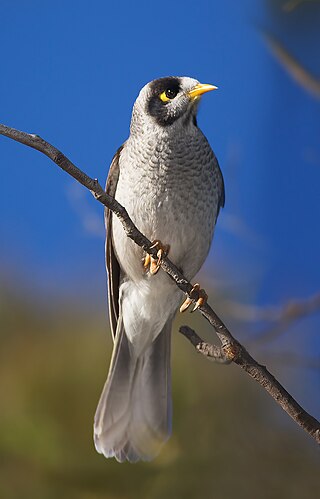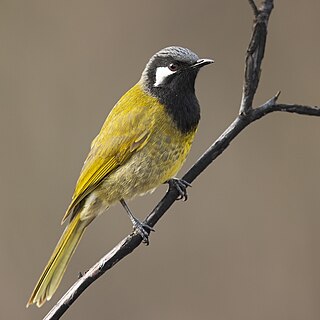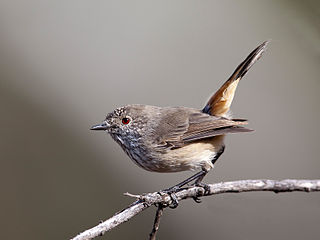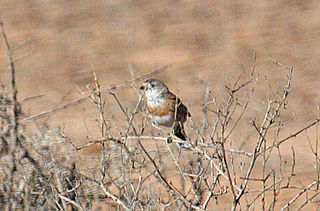
The black-faced woodswallow is a woodswallow of the genus Artamus native to Australia, New Guinea and the Sunda Islands, including Timor. It is 18–19 cm (7.1–7.5 in) long and is the most widespread species in the family Artamidae. Woodswallows have a soft call with chiff, chap and chattering calls which can include vocal mimicry

The noisy miner is a bird in the honeyeater family, Meliphagidae, and is endemic to eastern and southeastern Australia. This miner is a grey bird, with a black head, orange-yellow beak and feet, a distinctive yellow patch behind the eye, and white tips on the tail feathers. The Tasmanian race has a more intense yellow panel in the wing, and a broader white tip to the tail. Males, females and juveniles are similar in appearance, though young birds are a brownish-grey. As the common name suggests, the noisy miner is a vocal species with a large range of songs, calls, scoldings and alarms, and almost constant vocalisations, particularly from young birds. One of four species in the genus Manorina, the noisy miner itself is divided into four subspecies. The separation of the Tasmanian M. m. leachi is of long standing, and the mainland birds were further split in 1999.

The bell miner, commonly known as the bellbird, is a colonial honeyeater, endemic to southeastern Australia. The common name refers to their bell-like call. 'Miner' is an old alternative spelling of 'myna', and is shared with other members of the genus Manorina. The birds feed almost exclusively on the dome-like coverings, referred to as 'bell lerps', of certain psyllid bugs that feed on eucalyptus sap from the leaves. The psyllids make these bell lerps from their own honeydew secretions in order to protect themselves from predators and the environment.

The spinifex pigeon, also known as the plumed-pigeon or gannaway pigeon, is one of four endemic Australian bird species within the genus Geophaps. It occurs within a broader group known as bronzewing pigeons. This species is listed under the International Union for Conservation of Nature (IUCN) Red List category of "least concern". It most frequently occurs in arid and semi-arid habitats containing hummock-forming grasses of the genera Triodia and Plectrachne.

The red-browed pardalote is a small brightly coloured insectivorous passerine, endemic to Australia. A gleaning specialist, they forage primarily in eucalypt trees . The Latin word rubricatus means 'red-ochred' which is descriptive of their orange-red eyebrow. Other common names include red-browed diamondbird, bellbird, cape red-browed, pale red-browed, fawn-eyed, fawn-eyebrowed and pallid or red-lored pardalote.

The white-plumed honeyeater is a small passerine bird endemic to Australia. White-plumed honeyeaters are common around water and are often seen in backyards and suburbs with vegetation cover.

The weebill is a species of bird in the family Acanthizidae. It is an insectivorous passerine that is found throughout mainland Australia. At 8 to 9 cm long, it is Australia's smallest bird. It was originally described by John Gould in 1838, and four subspecies are recognised. The weebill's plumage is nondescript, with olive-grey upperparts and paler, more yellowish underparts. It grades from more brownish plumage in the southern regions of Australia to more yellow in tropical areas.

The white-eared honeyeater is a medium-sized honeyeater found in Australia. It is a member of the family Meliphagidae which has 190 recognised species with about half of them found in Australia. This makes them members of the most diverse family of birds in Australia. White-eared honeyeaters are easily identifiable by their olive-green body, black head and white ear-patch.

The red-capped robin is a small passerine bird native to Australia. Found in drier regions across much of the continent, it inhabits scrub and open woodland. Like many brightly coloured robins of the family Petroicidae, it is sexually dimorphic. Measuring 10.5–12.5 cm (4.1–4.9 in) in length, the robin has a small, thin, black bill, and dark brown eyes and legs. The male has a distinctive red cap and red breast, black upperparts, and a black tail with white tips. The underparts and shoulders are white. The female is an undistinguished grey-brown. This species uses a variety of songs, and males generally sing to advertise territories and attract females. Birds are encountered in pairs or small groups, but the social behaviour has been little studied.

The inland thornbill was originally described by English ornithologist John Gould in The Birds of Australia. Inland thornbills are within the order passerines. The inland thornbill belongs to the genus Acanthiza, which now has three more species than the eleven outlined by Gould in The Birds of Australia. The Noongar people of southwestern Western Australia call A. apicalis "Djoobi-Djoolbang". The inland thornbill is also known as the broad-tail thornbill and presently contains several subspecies that were once considered independent species. The word apicalis comes from the Latin for 'tipped'.

The red-chested buttonquail is a species of bird in the family Turnicidae. It is endemic to Australia. The species is generally regarded as widespread, although uncommon, in New South Wales, Queensland, northern Western Australia and the Northern Territory, and classified as Vulnerable in Victoria.

The chestnut-rumped thornbill is a small passerine bird in the family Acanthizidae, endemic to Australia.

The scrubtit is a species of bird in the thornbill family Acanthizidae. It is endemic to Tasmania and King Island in Australia. Its natural habitat is the temperate rainforest, Nothofagus beech forest and eucalypt woodland. It is a small species that resembles the Sericornis scrubwrens.

The Eyrean grasswren is a small grasswren from the Passerine family Maluridae. This is a cryptically plumaged and uncommon bird endemic to arid regions of Central Australia. The species was discovered by F.W. Andrews in 1874 around the Macumba River at Lake Eyre, and named after the South Australian Surveyor General George Woodroffe Goyder.

Aphelocephala is a genus of bird in the thornbill family Acanthizidae. The three species are collectively known as whitefaces. They are endemic to Australia, generally occurring in the arid centre of the continent. They are a striking looking bird, particularly compared to their duller looking relatives, having dark upperparts and white breasts and faces. Two species, the chestnut-breasted and banded whitefaces, break up the white undersides with a darker band. The three species have stubby bills and unlike the rest of the Acanthizidae they consume large numbers of seeds in their diet.

The banded whiteface is a species of bird in the family Acanthizidae. It is endemic to dryer regions of Australia.

The chestnut quail-thrush is a native Australian bird of the family Cinclosomatidae. These scrub birds are endemic to Australia and found in all states - barring Tasmania. They are relatively uncommon and are isolated to the semi-arid and arid fringes of the Australian interior.

The western yellow robin is a species of bird in the Australasian robin family, Petroicidae, native to Australia. Described by John Gould in 1838, the western yellow robin and its Australian relatives are not closely related to either the European or American robins, but they appear to be an early offshoot of the Passerida group of songbirds. Ranging between 13.5 and 15.5 cm long, it has grey upperparts, and a grey breast and head, broken by whitish streaks near the bill and below the eye, with a conspicuous yellow belly. The sexes are similar in appearance. Two subspecies are recognized: subspecies griseogularis, which has a yellow rump, and subspecies rosinae with an olive-green rump.

The white-browed babbler is a small, gregarious species of bird in the family Pomatostomidae. They are endemic to the open woodlands and shrubby areas of central and southern Australia. The Latin name superciliosus refers to the supercilium or ‘eyebrow’, which is a feature synonymous with the pomatostomine babblers.

The redthroat is a small, mostly ground-dwelling species of bird in the family Acanthizidae. It is endemic to Australia, occurring mostly in arid and semi-arid areas containing acacia and chenopod shrublands. The species has a distinctive red throat patch and is able to mimic the calls of numerous other bird species.





















